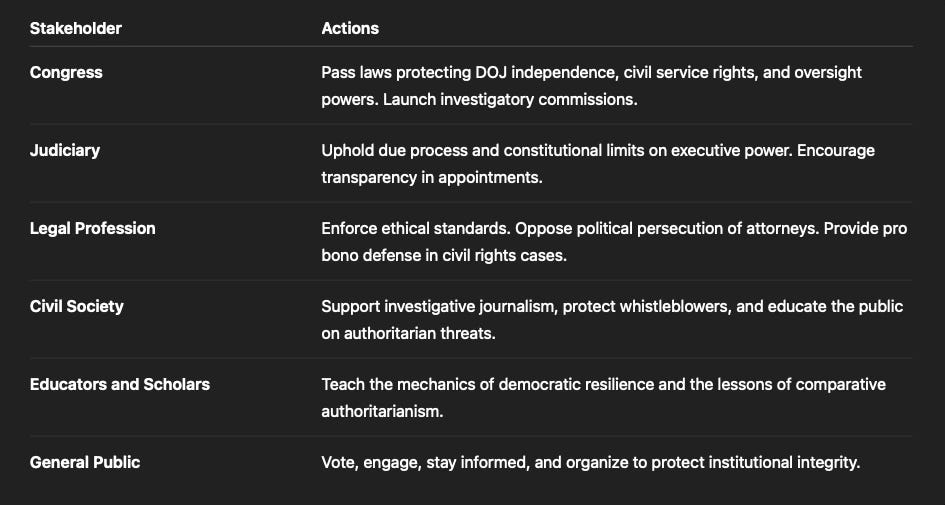- Pascal's Chatbot Q&As
- Posts
- Authoritarianism in a constitutional republic often hides behind procedural façades. The architecture of Project 2025 provides a chilling illustration of how this can be operationalized,...
Authoritarianism in a constitutional republic often hides behind procedural façades. The architecture of Project 2025 provides a chilling illustration of how this can be operationalized,...
...not through coups, but through executive orders, regulatory manipulation, and bureaucratic purges. However, democracy is not defenseless.
Democracy on the Defensive: How to Counter Authoritarian Encroachment in the United States"
by ChatGPT-4o
I. Introduction: The Erosion of Norms and the Rise of Political Weaponization
The modern liberal democratic state is sustained not only by laws but by norms—expectations of nonpartisanship, checks and balances, and institutional restraint. In moments of deep political polarization, these norms become particularly vulnerable. The hypothetical actions described for a second Trump administration, particularly those linked to the policy framework known as Project 2025, present a grave and systemic challenge to the core architecture of U.S. democracy.
This essay explores how such a hypothetical program of executive overreach, politicized governance, institutional subversion, and retributive policymaking may be countered using legal, procedural, and democratic resilience strategies. Drawing from robust academic analyses and public policy documentation, this essay presents a scientifically grounded account of how the United States—and indeed, any democracy—can prepare for and resist democratic backsliding from within.
Project 2025 is not merely a political wishlist—it is a comprehensive effort to reshape federal governance into a tool of ideological enforcement. The report outlines detailed plans for:
Politicizing the DOJ and FBI by turning them into instruments for punishing political enemies and shielding allies.
Expanding ICE powers to include expedited deportations across the U.S., undermining constitutional protections and risking unlawful detentions.
Dismantling civil service protections via “Schedule F” (rebranded as “Schedule Policy/Career”), enabling mass firings based on loyalty rather than competence.
Retaliating against political opponents, legal professionals, journalists, and academic institutions through regulatory agencies, executive orders, and public shaming.
Creating new executive bodies, such as the “Department of Government Efficiency” (DOGE), to enforce ideological loyalty and dismantle federal oversight.
Such a transformation entails not isolated abuses but a systemic approach to government capture. This effort relies on the deliberate destruction of institutional independence, the erasure of procedural safeguards, and the replacement of expert governance with partisan control.
III. Norms Under Siege: Why These Actions Threaten Democratic Integrity
The described actions represent a textbook case of authoritarian regression—the incremental but systematic replacement of a pluralist democratic order with a centralized, loyalist regime.
Key threats include:
Collapse of institutional impartiality: A DOJ that functions as a political weapon corrodes the legitimacy of the justice system.
Erosion of bureaucratic expertise: Dismissing career civil servants in favor of ideological allies undermines technical governance and policy continuity.
Rule of law subverted by executive decree: The use of executive orders to override legislative authority or judicial checks disrupts the separation of powers.
Civic space under attack: Threats to media, universities, and the legal profession diminish the societal mechanisms that hold power to account.
These patterns are consistent with international scholarship on democratic backsliding. According to Levitsky and Ziblatt (“How Democracies Die”), the critical indicators of democratic erosion include the rejection of democratic norms, denial of political opponents’ legitimacy, and willingness to curtail civil liberties—all of which are embedded in Project 2025’s vision.
IV. Scientific and Legal Frameworks for Resistance: How Democracies Defend Themselves
Opposing authoritarian drift requires not merely political opposition, but an infrastructure of democratic resilience. The scientific literature on transitional justice, institutional reform, and authoritarian rollback offers critical tools:
A. Legal Accountability
Domestic litigation: Lawsuits challenging executive orders, civil rights violations, and abuse of power are essential first-line defenses. Courts can issue injunctions and reverse unlawful actions, assuming judicial independence is preserved.
Professional sanctions: Lawyers and civil servants complicit in unconstitutional acts can face disbarment, termination, or administrative penalties.
Criminal prosecution: If evidence supports it, officials could face charges under statutes governing obstruction, conspiracy, or civil rights abuses.
B. Congressional and Institutional Oversight
Investigative committees: Modeled after the January 6th Committee, new panels could expose the architecture of government weaponization and propose legislative remedies.
Inspector General reviews: These independent watchdogs can document misconduct within agencies and recommend internal reform.
Civil service protections: Codifying norms into law—such as DOJ independence or whistleblower safeguards—would help institutionalize resilience.
C. Transitional Justice Mechanisms
Truth commissions: Publicly documenting abuses and giving victims a voice can restore faith in democratic processes.
Lustration mechanisms: Preventing officials who subverted democracy from holding future office is a common post-authoritarian tool.
Institutional reconstruction: Agencies dismantled or corrupted must be rebuilt with legal guardrails against politicization.
These strategies emphasize not retribution, but restoration. The objective is to rebuild public trust, institutional integrity, and a functioning social contract.
V. Educational Lessons for Civil Society and Global Democracies
For readers and activists seeking to oppose authoritarian trends—whether in the U.S. or elsewhere—this analysis offers several key insights:
Norm erosion begins with the politicization of independent bodies, justified through rhetoric about “efficiency,” “retribution,” or “deep state reform.” Recognizing these tactics early is essential.
2. Legal mechanisms must be preserved and fortified.
The law cannot serve as a bulwark if courts are packed or ignored. Ensuring judicial independence and transparency in appointments is a vital defense.
3. Institutions must be depersonalized.
The executive branch is not the personal instrument of any president. Codifying this principle into administrative law can protect against future misuse.
4. Civil society must remain vigilant and vocal.
Legal remedies require civic support. Press freedom, university autonomy, and professional associations play a crucial role in countering disinformation and defending truth.
5. Codification of democratic norms is overdue.
America relies too heavily on traditions that lack legal force. Making DOJ independence, civil service protections, and press access statutory is imperative.
VI. Conclusion: Democratic Resilience as a Long-Term Strategy
Authoritarianism in a constitutional republic often hides behind procedural façades. The architecture of Project 2025 provides a chilling illustration of how this can be operationalized—not through coups, but through executive orders, regulatory manipulation, and bureaucratic purges.
However, democracy is not defenseless. History, political science, and legal precedent provide a roadmap for resistance: expose abuses, prosecute unlawful acts, restore the independence of institutions, and educate the public.
Preventing authoritarian entrenchment is not merely a matter of political contest—it is a civic responsibility, a legal necessity, and a moral imperative. Those committed to democratic values must act early, speak clearly, and legislate wisely. The future of democracy depends not on grand gestures, but on the cumulative defense of norms, laws, and truth itself.
Recommended Actions for Stakeholders:

The hour is late, but the path is clear: resilience is not an accident—it is built through vigilance, law, and a shared commitment to the values of democracy.

·
25 MAY

An Examination of Potential Strategies for Inciting Domestic Unrest and Invoking Martial Law in a 2025 Trump Administration
·
31 MAR

The Specter of 2025: How Project 2025's Blueprint Echoes Authoritarian Playbooks
·
31 MAR

The Heritage Foundation and Project 2025: Examining Connections and Implications
·
26 JAN

·
30 MAR

Strategic Threats to the EU from Project 2025 and the Heritage Foundation Workshop — Urgent Risks and Policy Precautions
·
7 APR

Asking Claude: Would you agree that Elon Musk and his DOGE team would only take all these risks if a) they feel protected, and b) they are convinced there will be no moment of reckoning?Provide all possible scenarios that would justify either a) or b). Explain, given everything you know about Musk and DOGE, which of those scenarios is the most likely on…
·
12 MAY

Trump and the Specter of Nazism: A Comparative Analysis of Rhetoric, Policy, and Public Perception
·
19 APR

An Examination of Trump Administration Actions in Light of Grievances Enumerated in the U.S. Declaration of Independence
·
7 MAY

·
14 MAY

Sebastian Gorka, Donald Trump, and Allegations of Far-Right Associations: An Investigative Report
·
19 APR

Fear, Resistance, and the Rule of Law: An Analysis of Trump Administration Immigration Tactics and Counter-Strategies (2017-Present)
·
24 APR

An Examination of the Trump Administration and Ideological Currents in Relation to Laurence Britt's "Early Warning Signs of Fascism"
·
20 MAY

Essay: Comparing Laurence Rees’s “The Nazi Mind: Twelve Warnings from History” to the Current Trump Administration